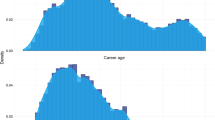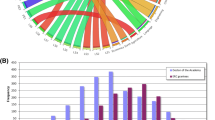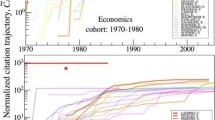Abstract
In an earlier exercise some demographic methods were reformulated for application in a scientometric context. Age-pyramids based on annual publication output and citation impact was supplemented by the change of the mean age of the publications in the h-core at any time. Although the method was introduced to shed some demographic–scientometric light on the career of individual researchers, the second component, i.e., the age dynamics of the h-core can however be applied to higher levels of aggregation as well. However, the found paradigmatic shapes and patterns do not only characterise individual careers and positions, but are also typical of life cycles and subject-specific peculiarities. In the present study, the proposed approach is used to visualise the careers of scientists active in different fields of the sciences and social sciences and notably the second component, the h-core dynamics, is extended to the analysis of scientific journals from the same fields. In addition to the dynamics of productivity and citation impact, the evolution of co-authorship patterns of the same scientists is studied to capture another facet of individual academic careers.








Similar content being viewed by others
References
Baldi, S. (1998). Normative versus social constructivist processes in the allocation of citations: A network-analytic model. American Sociological Review, 63, 829–846.
Bar-Ilan, J. (2006). H-index for Price medalists revisited. ISSI Newsletter, 2(1), 3–5.
Bar-Ilan, J. (2010). A follow-up on the h-index of Price medalists. ISSI Newsletter, 22(2), 39–43.
Batista, P. D., Campiteli, M. G., Kinouchi, O., et al. (2006). Is it possible to compare researchers with different scientific interests? Scientometrics, 68(1), 179–189.
Beaver, D. D. (2004). Does collaborative research have greater epistemic authority? Scientometrics, 60(3), 399–408.
Beaver, D. D., & Rosen, R. (1978). Studies in scientific collaboration. Part I. The professional origins of scientific co-authorship. Scientometrics, 1, 65–84.
Beaver, D. D., & Rosen, R. (1979). Studies in scientific collaboration, part II. Scientific co-authorship, research productivity and visibility in the French elite. Scientometrics, 1, 133–149.
Braun, T., Glänzel, W., & Schubert, A. (2001). Publication and co-operation patterns of the authors of neuroscience journals. Scientometrics, 51(3), 499–510.
Braun, T., Glänzel, W., & Schubert, A. (2005). A Hirsch-type index for journals. The Scientist, 19(22), 8.
Braun, T., Glänzel, W., & Schubert, A. (2006). A Hirsch-type index for journals. Scientometrics, 69(1), 169–173.
Burrell, Q. L. (2007). Hirsch index or Hirsch rate? Some thoughts arising from Liang’s data. Scientometrics, 73(1), 19–28.
Cronin, B., & Meho, L. (2006). Using the h-index to rank influential information scientists. Journal of the American Society for Information Science and Technology, 57(9), 1275–1278.
Cronin, B., & Meho, L. (2007). Timelines of creativity: A study of intellectual innovators in information science. Journal of the American Society for Information Science and Technology, 58(13), 1948–1959.
Egghe, L. (2006). Theory and practise of the g-index. Scientometrics, 69(1), 131–152.
Endersby, J. W. (1996). Collaborative research in the social sciences: Multiple authorship and publication credit. Social Science Quarterly, 77, 375–392.
Gazni, A., & Didegah, F. (2011). Investigating different types of research collaboration and citation impact: a case study of Harvard University’s publications. Scientometrics, 87(2), 251–265.
Glänzel, W. (2002). Coauthorship patterns and trends in the sciences (1980–1998): A bibliometric study with implications for database indexing and search strategies. Library Trends, 50(3), 461–473.
Glänzel, W. (2006). On the opportunities and limitations of the h-index. Science Focus, 1(1), 10–11. (in Chinese).
Glänzel, W., & Persson, O. (2005). H-index for Price medalists. ISSI Newsletter, 1(4), 15–18.
Glänzel, W., & Schoepflin, U. (1994). A stochastic model for the ageing analyses of scientific literature. Scientometrics, 30(1), 49–64.
Glänzel, W., & Thijs, B. (2004). Does co-authorship inflate the share of self-citations? Scientometrics, 61(3), 395–404.
Glänzel, W., & Zhang, L. (2010). A demographic look at scientometric characteristics of a scientist’s carrier. ISSI Newsletter, 6(3), 66–84.
Ho, Y. S. (2004). Citation review of Lagergren kinetic rate equation on adsorption reactions. Scientometrics, 59(1), 171–177.
Jensen, P., Rouquier, J. B., & Croissant, Y. (2009). Testing bibliometric indicators by their prediction of scientists promotions. Scientometrics, 78(3), 467–479.
Jin, B. H., Liang, L. M., Rousseau, R., et al. (2007). The R- and AR-indices: Complementing the h-index. Chinese Science Bulletin, 52(6), 855–863.
Kliegl, R., & Bates, D. (2011). International collaboration in psychology is on the rise. Scientometrics, 87(1), 149–158.
Kretschmer, H. (1994). Co-authorship networks of invisible colleges and institutional communities. Scientometrics, 30(1), 363–369.
Kretschmer, H. (2002). Similarities and dissimilarities in coauthorship networks: Gestalt theory as explanation for well-ordered collaboration structures and production of scientific literature. Library Trends, 50(3), 474–497.
Levitt, J. M., & Thelwall, M. (2009). The most highly cited Library and Information Science articles: Interdisciplinarity, first authors and citation patterns. Scientometrics, 78(1), 45–67.
Liang, L. (2006). H-index sequence and h-index matrix: Constructions and applications. Scientometrics, 69(1), 153–159.
Molinari, A., & Molinari, J. F. (2008). Mathematical aspects of a new criterion for ranking scientific institutions based on the h-index. Scientometrics, 75(2), 339–356.
Moody, J. (2004). The structure of a social science collaboration network: Disciplinary cohesion from 1963 to 1999. American Sociological Review, 69(2), 213–238.
Price, D. D., & Gürsey, S. (1976). Studies in scientometrics. Part 1. Transience and continuance in scientific authorship. International Forum on Information and Documentation, 1, 17–24.
Schubert, A., & Glänzel, W. (2007). A systematic analysis of Hirsch-type indices for journals. Journal of Informetrics, 1(3), 179–184.
Zhang, L., & Glänzel, W. (2011). Where demographics meets scientometrics: Towards a dynamic career analysis. In: E. Noyons, P. Ngulube, & J. Leta (Eds.), Proceedings of ISSI 2011—The 13th International Conference on Scientometrics and Informetrics, Durban, 4–7 July 2011, pp. 914–923.
Acknowledgments
The present study is an extended version of a paper presented at the 13th International Conference on Scientometrics and Informetrics, Durban (South Africa), 4–7 July 2011 (Zhang and Glänzel 2011). The first author would like to acknowledge the support from the National Natural Science Foundation of China under Grant 71103064.
Author information
Authors and Affiliations
Corresponding author
Rights and permissions
About this article
Cite this article
Zhang, L., Glänzel, W. Where demographics meets scientometrics: towards a dynamic career analysis. Scientometrics 91, 617–630 (2012). https://doi.org/10.1007/s11192-011-0590-8
Received:
Published:
Issue Date:
DOI: https://doi.org/10.1007/s11192-011-0590-8




